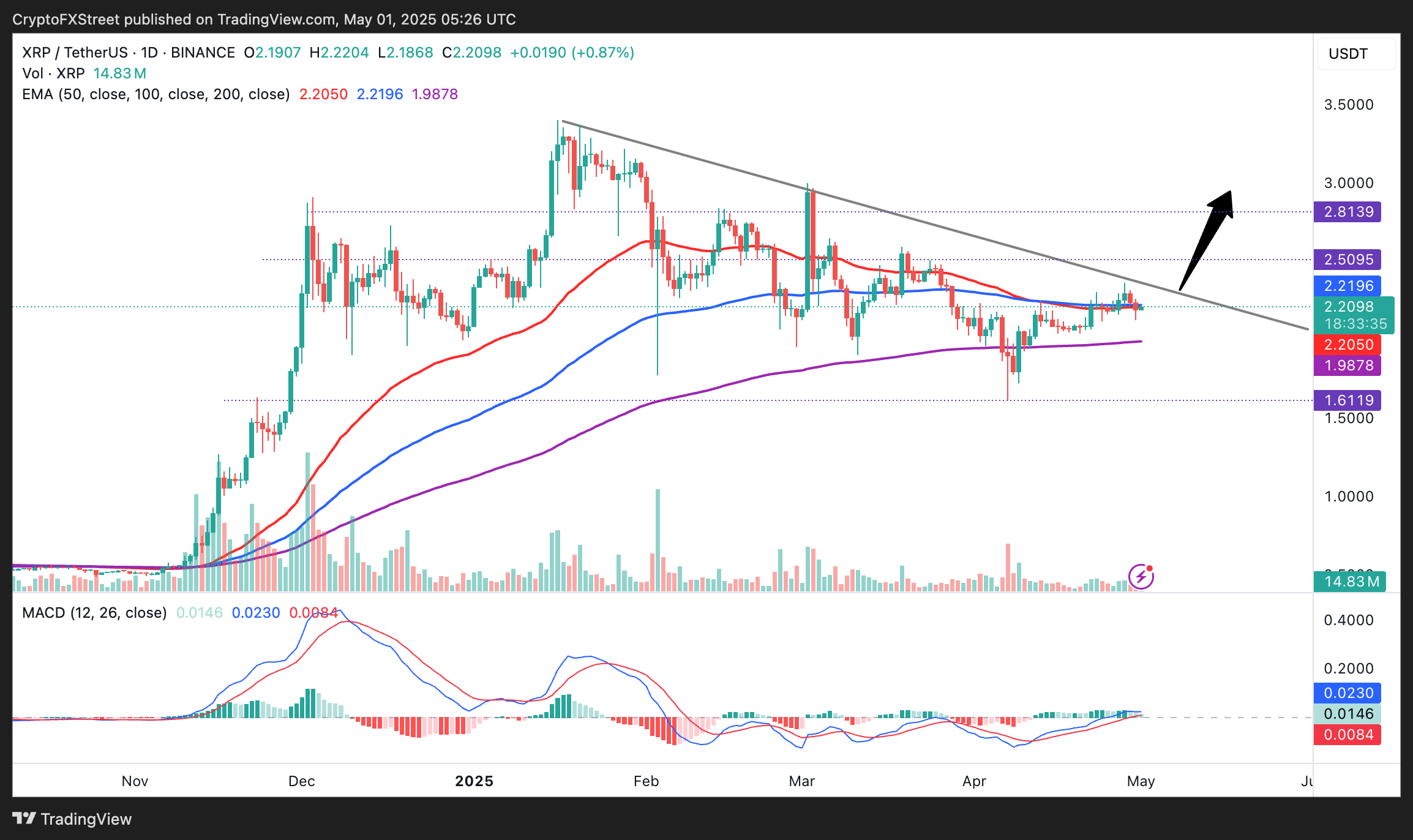Ripple Price Forecast: XRP builds bullish momentum as Ripple eyes Circle with $5B acquisition bid
- XRP’s price uptrend could persist as long as bulls maintain strong control over the $2.20 confluence support level.
- Ripple offers $5 billion to acquire Circle to accelerate its influence in the fast-growing stablecoin market.
- Circle rejects Ripple’s acquisition bid and will focus on going public following the IPO announcement.
- The MACD indicator upholds XRP’s bullish outlook, targeting $3.00 in the medium term.
Ripple’s (XRP) price is consolidating at $2.21 at the time of writing on Thursday, reflecting sideways trading in the wider cryptocurrency market. There is a growing need for XRP to hold above the immediate $2.20 confluence support to validate the potential breakout targeting $3.00. Meanwhile, Ripple’s $5 billion bid to acquire Circle, the company that issues USDC stablecoin, has caught the industry’s attention.
Circle rejects Ripple’s $5 billion acquisition bid
Ripple recently made public its bid to acquire Circle, one of the cryptocurrency market’s reputable issuers of stablecoins, for an estimated $4 - 5 billion. Circle is the issuer of USDC, the second-largest stablecoin, with a market capitalization of $61.5 billion.
Ripple's acquisition of Circle would immediately increase its stake in the stablecoin market, which it entered in 2024 with the launch of Ripple USD (RLUSD). RLUSD’s market capitalization stands at $316 million, a significant achievement in a few months.
However, Circle will not consider Ripple’s bid, citing its recently unveiled plans to go public via an initial public offering (IPO). The stablecoin company has filed the necessary documents in the United States (US).
According to Forbes, “Circle’s decision to reject the offer isn’t just a story about price—it’s a signal of conviction,” at the same time, it is “positioning USDC as a global standard for dollar-backed stablecoins, doubling down on its reputation for transparency, compliance, and innovation.”
Ripple’s bid to acquire Circle comes after the company completed the purchase of Hidden Road, a brokerage firm, for $1.25 billion on April 8. This was Ripple’s largest acquisition, underscoring the company’s strategy to expand beyond the crypto industry, seeking opportunities in the traditional financial sector.
Hidden Road will leverage the RLUSD stablecoin as collateral across its prime brokerage products and shift its post-trade activity to the XRP Ledger blockchain.
Can XRP price reignite bullish momentum?
XRP’s bullish outlook follows positive sentiments in the broader crypto market from mid-April, accelerated by the US easing trade tensions with China while working on a short-term agreement ahead of a long-term deal.
President Donald Trump also stepped back from launching a global trade war after he suspended reciprocal tariffs for 90 days, except for China, on April 9. Sentiment improved significantly, with returns flipping positively in April.
XRP currently hovers at $2.21, with the confluence support established by the 50- and 100-day Exponential Moving Averages (EMAs). The Moving Average Convergence Divergence (MACD) indicator confirms the uptrend after crossing above the mean line, accompanied by green histograms. The buy signal highlighted by this indicator was triggered when the MACD line (blue) crossed above the signal line (red) on April 11.
If the bulls hold firmly above the $2.20 confluence support, XRP could launch the next bid to breach the descending trend line resistance. Beyond this resistance cloud, it would be prudent for traders to monitor XRP’s price behavior around previously tested supply zones at $2.50, $2.80, and $3.00.

XRP/USDT daily chart
Despite positive sentiment in the market, traders should prepare for other outcomes, including a rejection from the confluence level at $2.20. Such a move could increase volatility, followed by deeper drawdowns to the 200-day EMA at $1.98. An accelerated decline below this moving average may retest XRP’s April low at $1.61 to collect liquidity before another attempt at reversing the trend.
Ripple FAQs
Ripple is a payments company that specializes in cross-border remittance. The company does this by leveraging blockchain technology. RippleNet is a network used for payments transfer created by Ripple Labs Inc. and is open to financial institutions worldwide. The company also leverages the XRP token.
XRP is the native token of the decentralized blockchain XRPLedger. The token is used by Ripple Labs to facilitate transactions on the XRPLedger, helping financial institutions transfer value in a borderless manner. XRP therefore facilitates trustless and instant payments on the XRPLedger chain, helping financial firms save on the cost of transacting worldwide.
XRPLedger is based on a distributed ledger technology and the blockchain using XRP to power transactions. The ledger is different from other blockchains as it has a built-in inflammatory protocol that helps fight spam and distributed denial-of-service (DDOS) attacks. The XRPL is maintained by a peer-to-peer network known as the global XRP Ledger community.
XRP uses the interledger standard. This is a blockchain protocol that aids payments across different networks. For instance, XRP’s blockchain can connect the ledgers of two or more banks. This effectively removes intermediaries and the need for centralization in the system. XRP acts as the native token of the XRPLedger blockchain engineered by Jed McCaleb, Arthur Britto and David Schwartz.

